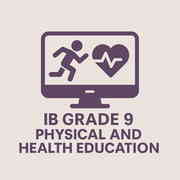Professional Courses
Industry-relevant training in Business, Technology, and Design
Categories
Interactive Games
Fun games to boost memory, math, typing, and English skills
Typing
Memory
Math
English Adventures
Knowledge

IB MYP Grade 9 Physical and Health Education
Welcome to "Thriving Through Movement: IB MYP Grade 9 Physical and Health Education"! This engaging online course is meticulously designed to immerse students in the multifaceted world of physical activity, health concepts, and holistic well-being, directly aligned with the International Baccalaureate (IB) Middle Years Programme (MYP) for Grade 9. This course moves beyond traditional sports instruction, fostering a deep understanding of the principles that underpin physical and mental health. We will explore key concepts such as development, identity, choice, and systems, applying them to real-world scenarios in health and physical activity. Through interactive modules, practical challenges (adapted for an online environment), critical analysis of health information, and reflective exercises, students will cultivate essential ATL (Approaches to Learning) skills, including self-management, communication, collaboration, and critical thinking. The curriculum covers a diverse range of topics, including understanding movement principles, evaluating health information, personal fitness and goal setting, nutrition, mental well-being, and the social and cultural aspects of sport and physical activity. Students will be encouraged to explore various forms of physical activity, analyze their own habits, and develop strategies for lifelong well-being. By the end of this course, students will be equipped with the knowledge, skills, and positive attitudes necessary to make informed choices about their physical, social, emotional, and mental health, becoming proactive and responsible custodians of their own well-being and contributing to the health of their communities. This course prepares students for success in their Grade 9 PHE assessments and for a lifetime of healthy living within the IB MYP and beyond.
Course Chapters
Welcome and Course Introduction
The module serves as an introduction to the IB MYP Physical and Health Education framework, highlighting its aims and objectives. Key components include holistic learning, the significance of physical activity, and the development of essential Approaches to Learning (ATL) skills. The chapter also outlines the importance of academic honesty and responsible practice in the context of health and physical activities.
Understanding Movement: Principles and Performance
Human movement is a complex phenomenon governed by the coordination of various body systems, mechanical principles, and components of fitness. Key systems include muscular, skeletal, and nervous systems, which interplay to enable motion. Additionally, understanding biomechanics enhances the efficiency of movement, while the focus on fitness components like cardiovascular endurance and muscle strength supports overall health and performance.
Personal Fitness and Goal Setting
The chapter focuses on personal fitness and goal setting, outlining the essential principles of training, methods for self-assessment, and techniques for setting effective fitness goals. It encompasses the design of personalized activity plans, the importance of safety in physical activity, and how to interpret personal fitness data to facilitate continuous improvement. By the end, individuals are empowered to take informed steps toward achieving their fitness aspirations.
Nourishing the Body: Nutrition and Hydration
Understanding nutrition and hydration is fundamental for maintaining optimal health and well-being. Key nutrients include macronutrients such as carbohydrates, proteins, and fats, alongside micronutrients like vitamins and minerals, each playing distinct roles in bodily functions. A balanced diet emphasizes food variety and proper portion control, while hydration is critical for numerous physiological processes. Finally, debunking common nutrition myths and understanding food labels empowers individuals to make informed dietary choices.
Mental and Emotional Well-being
The chapter discusses mental and emotional well-being as an essential aspect of holistic health, highlighting the definition of mental well-being, common challenges like stress and anxiety, and the importance of reducing stigma. It offers practical strategies for stress management, enhancing emotional intelligence, building resilience, and fostering self-esteem, as well as exploring the link between physical activity and mental health.
Social Dynamics and Community Health
Social dynamics profoundly influence individual and community health, with factors such as collaboration, teamwork, and leadership in physical activities reinforcing vital skills. Cultural dimensions of sport reflect historical and communal identities, while health disparities arise from socio-economic conditions and environmental factors. Promoting health involves shared responsibility among individuals, families, and governments, particularly in addressing risk-taking behaviors impacted by peer pressure and decision-making.
Evaluating Health Information and Consumer Choices
The module provides vital skills to critically analyze health information from various sources, foster informed consumer choices regarding health products and services, and promote advocacy for health in communities. It emphasizes the importance of media literacy, the identification of credible health resources, and evaluating fitness products, dietary supplements, and health services while encouraging individual and group advocacy efforts for better health outcomes.
